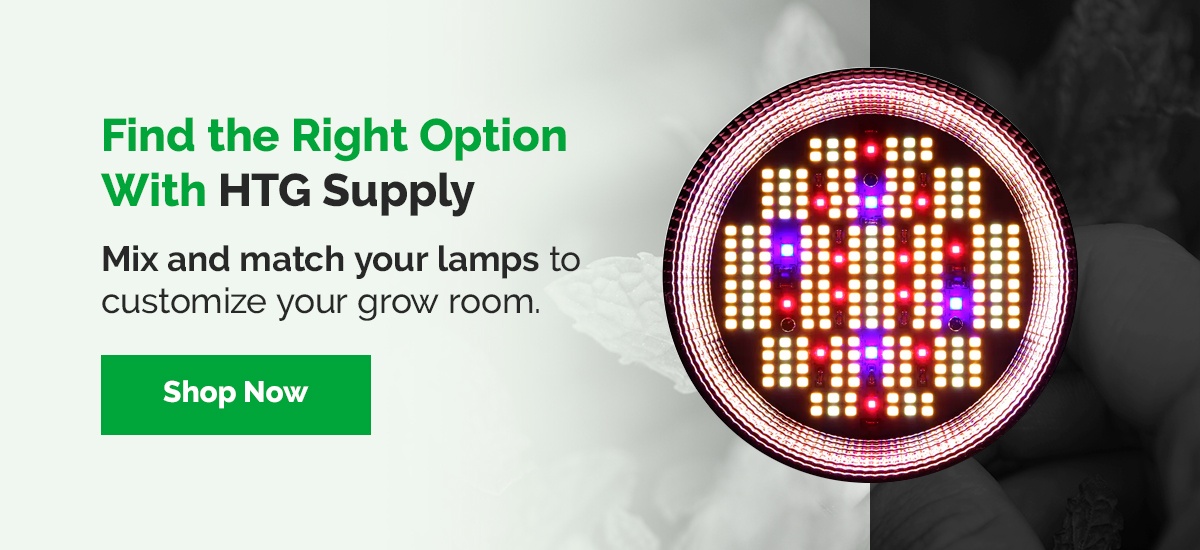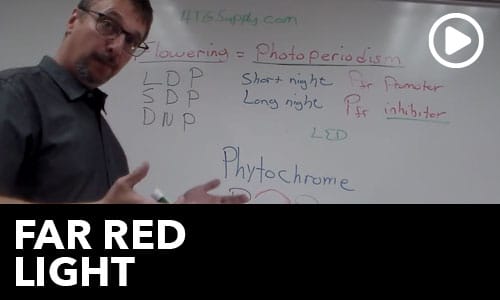When choosing grow lights for your home grow room, you have plenty of options. Light-emitting diodes (LEDs) are an increasingly popular choice. You’ll also find many high-intensity discharge (HID) lighting systems on the market. Even within HIDs, you have a choice between high-pressure sodium (HPS), metal halide (MH) and ceramic metal halides. To add even more options, grow lights can also have T5 or compact fluorescent bulbs.
In the great debate of HID, MH and HPS vs. LED grow lights, you’ll find proponents of all types. Some people have figured out a method that works for them and have great results with LEDs. Others sing praises for their HID grow lights and will never use anything else. They both have their advantages, and the right one for you might depend mainly on your preferences. The best lights for your plant nursery can also change based on your setup and growing conditions.
To help you find your ideal lighting setup, we created this deep-dive comparison of LED and HID grow lights.
What Is the Difference Between HID and LED Grow Lights?
Are LED or HID grow lights better? Professional and home growers alike have been debating the topic since LED grow lights first arrived on the market. The answer depends on your goals. To understand which one is right for you, it helps to look at the technology behind LED compared to HID grow lights. A comparison of HPS and LED grow lights should also consider other types of HIDs, like MHs and CMHs.
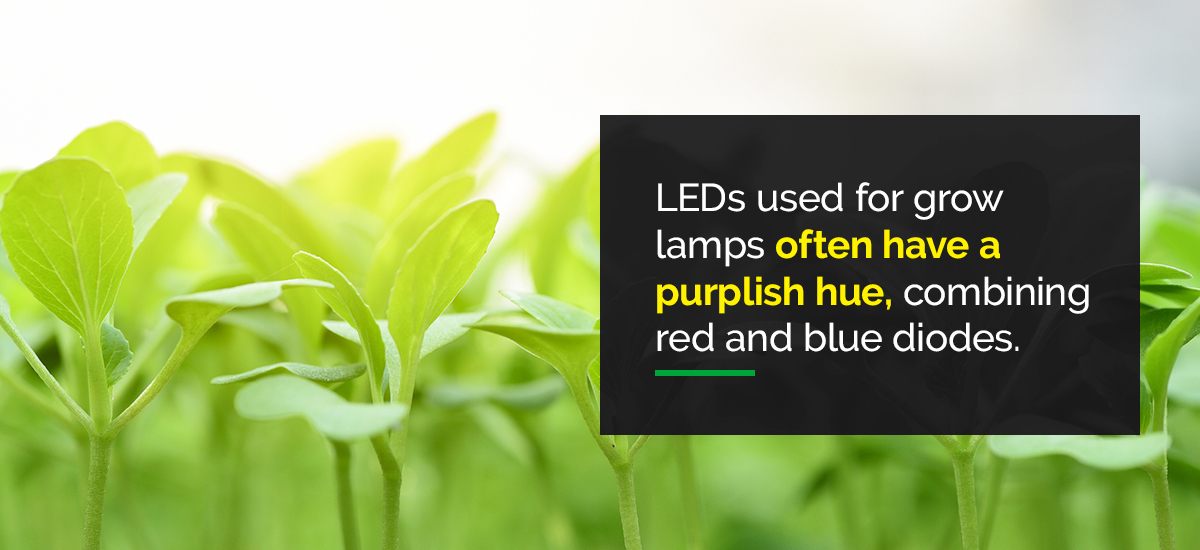
What Are LED Grow Lights?
LED stands for light-emitting diode. LED grow lights contain a grid of hundreds or even thousands of individual diodes or chips. The chips convert electricity directly into light, which is more energy-efficient than other bulb types.
Each diode produces a specific color. Blending different chips can create a broad or partial light spectrum. LEDs used for grow lamps often have a purplish hue, combining red and blue diodes. Many plants grow differently depending on the color spectrum they grow in. Blue light is usually preferred during the vegetative stage, while red wavelengths are best during bloom. With an LED grow lamp, you can customize and experiment with your lighting spectrum.
LED grow lights come in different shapes, sizes and features to meet many home growers’ needs. High-end, professional grow lights feature a large panel of diodes. Other smaller models are shaped like saucers or bars. Most of the LED grow lights we offer are rectangular, and our stock also includes pods, spotlights, bars and rods. Many LED lights use broad-spectrum or full-spectrum diodes, resulting in different hues of white or yellowish light. Others have higher concentrations of red or blue diodes, producing light for vegetative or flowering plants. Some LED grow lights let you control the color temperature using an app or control panel.
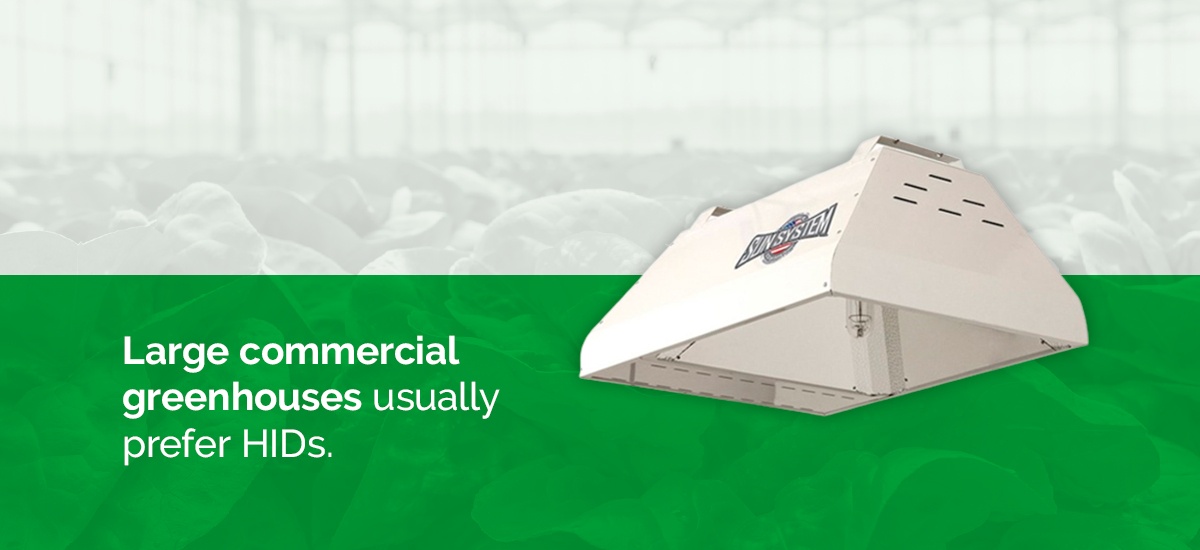
What Are HID Grow Lights?
HID stands for high-intensity discharge. The bulbs inside HID grow lights are tubes filled with gas and electrodes on either end. Electricity jumps from one electrode to the other, reacting with the gas to generate bright light.
While HID technology is older than LEDs, these lights have higher light output and brightness. HIDs can also come in double-ended configurations, which are brighter and more space-efficient than single-ended lamps. Large commercial greenhouses usually prefer HIDs.
Unlike LEDs, which can shift color depending on which diodes are illuminated, HIDs can only produce one color. The type of gas inside determines the light spectrum a bulb generates. To switch from a vegetative or full-spectrum light to a bloom configuration, you must physically change the bulb.
HID grow lights also come in several types. Metal halide (MH) and high-pressure sodium (HPS) are the two most common. To achieve the spectrum required for each growth stage, growers combine MH and HPS lamps and bulbs.
Metal Halide lamps produce a blueish light spectrum, which is excellent for the vegetative stage. A subcategory of MH lights, ceramic metal halide grow lights, give off a broad spectrum, replicating natural sunlight better than any other type of grow light. High-pressure sodium lights have a yellowish-orange hue, so they are ideal for flowering plants and adequate for vegetative plants.
![Pros of LED Lights [list]](https://e36jokz4maw.exactdn.com/wp-content/uploads/2021/03/04-Pros-of-LED-lights-pinterest.jpg?strip=all&lossy=0&sharp=1&resize=600%2C1050&ssl=1)
Pros of LED Lights
As a more advanced technology, LEDs offer many fantastic benefits for your grow room. Growers who love LEDs prefer them for many reasons.
They’re Cooler
LED bulbs run cooler than HIDs. While HIDs become more efficient the hotter they burn, LEDs are more efficient when they are cool. Too much heat in the grow room can increase moisture and condensation, which reduces airflow to the plants. Since home growers often risk overheating their grow room with HIDs, cooler LEDs are easier to work with. An LED grow light will produce more photons per watt when it is cooler.
While LEDs run cooler than HIDs already, some models also contain built-in cooling fans. These fans become an asset to your setup, rather than a necessary evil. They improve your grow light’s energy efficiency, reducing your operational costs. Also, since LEDs degrade faster under warmer conditions, fans improve their life span.
They’re More Energy Efficient
Compared to HIDs, you can use much lower wattage LED bulbs in your grow room. According to the Council for an Energy-Efficient Economy (ACEEE), the energy savings are dramatic. Vegetative grow lamps require a 600 watt (W) HID, compared to a 300 W LED. The annual savings in a grow room operating 365 days a year equates to 2,600 kilowatt-hours (kWh). Changing out a 1,000 W HID for a 600 W LED results in a 2,300 kWh annual savings.
Additionally, agricultural sites that switch to LEDs could save 31%-35% more electricity per square foot of growing area.
Watt for watt, LEDs produce more light. That means growers can choose a lower-watt lamp that draws less energy. An LED grow light’s construction also improves its energy efficiency. For example, HIDs require a ballast to convert wall-socket electricity into usable energy. LED grow lights plug right into a standard outlet, which means less energy loss through conversion. Since diodes convert electricity directly into light, there’s no energy lost to chemical reactions and heat. With the cooler operating temperatures of LEDs, you can also expend less energy cooling and ventilating your grow house.
They’re Easy to Use
Since LED lights plug into a standard wall socket, they’re more intuitive to most home growers. There are no ballasts to purchase or set up. You can just plug them in and get started. LEDs are often celebrated as an all-in-one package. A traditional grow lamp requires many components. Besides the ballast, you’ll also need to invest in a reflector, separate and replacement bulbs and a timer. LEDs require no reflector, have built-in timers and do not demand any separate bulbs unless you’re retrofitting an HID light.
Built-in cooling fans are also more user friendly. If you use HIDs, you’ll need to divert some airflow to cooling the lights. With cooling fans included, you have one less thing to worry about. Finally, since some LEDs have adjustable spectrum settings, you can customize the light to every growth stage. You’ll never have to switch out your bulbs or grow lamp system with an adjustable system.
You Can Customize the Lighting
Since an LED grow lamp contains individual, single-colored diodes, turning some on and off can change the overall output color. For lights with spectrum control features, an app or remote control lets you switch from full spectrum to vegetation or flowering settings as needed. Besides adjusting the color spectrum, you can also dim many LEDs or set them on timers. Through an app, you can even control them remotely.
Growers may want to dim their lights to 75% during the vegetative state when full light intensity is not required. During flowering, growers using lights that offer spectrum control may dim the blue lights to 50% while keeping the reds and whites at full strength. This offers more control of lighting to achieve specific results. Although red becomes most important when plants bloom, all wavelengths benefit all growth stages. Meanwhile, dimmability can help growers save even more energy than traditional lighting options.
Another built-in control feature available in some lights is scheduling. Since these lights can time themselves, you will not have to invest in external timers. With the increased customizability, you can even program specific light settings for every hour of the day. Switch from seedling to clone to vegetative growth to flowering at the touch of a button.
The Cost Has Gone Down With Time
One point of criticism LEDs have faced is their upfront cost. LEDs tend to be more expensive than other lights, so a home grower on a budget might be tempted to reach for the often-celebrated HIDs just for the affordability. Still, it’s important to note that the added cost pays for itself over time through better energy efficiency. Experts estimate that vegetative LED fixtures purchased at 2017 pricing pay for themselves within two to three years. More powerful flowering-stage lighting equipment purchased the same year would pay for themselves in three to four years.
Producing LEDs used to cost much more than it does today. The lights weren’t efficient enough to offset their high cost. A 2015 discovery yielded a more efficient bulb that was easier to manufacture, and it has since driven down the upfront cost. Technological improvements have continued to lower the cost even more. While the cost is still higher than an HID lamp, arguments that LEDs aren’t worth the price are outdated. LED grow lights get cheaper with each passing year.
They Last Longer
Besides the cost savings through improved energy efficiency, LEDs also last longer. Many manufacturers rate their LED grow lights for 50,000 hours. Some will last even longer. Depending on how long each light stays on per day, a single LED grow light could last almost 10 years or even longer. By comparison, MH bulbs last roughly 10,000 hours, and HPS bulbs last 16,000 hours.
Besides the longer life span, LEDs maintain their brightness throughout their life. HIDs will get dimmer as they’re used, which means growers may need to replace them even sooner. The longer service life per LED panel can also help offset the higher upfront costs.
They Make Great Supplemental Lights
While LEDs are excellent for many reasons, many growers hesitate to make the switch. HIDs are known for producing higher quality plants and have many other benefits of their own. Growers who want to maximize the benefits of both LEDs and HIDs can use LEDs to supplement their overall lighting setup.
Home gardeners can place LED lights under their canopies to help every part of the plant absorb light. They can also supplement HIDs overhead, increasing the overall light intensity in the grow room. Growers who use natural sunlight from a greenhouse can install LEDs for added light on cloudy days or to get in a few more hours of illumination each day.
Cons of LEDs
While LEDs are coveted among amateur growers for many reasons, they have a few drawbacks that make them less desirable for some situations.
Initial Costs Remain High
Even as the upfront cost decreases, it’s still higher than an HID system. While you can find affordable options among both LED and HID models, LEDs still cost more. The Department of Energy lists initial cost as the largest barrier to agricultural facilities adopting LEDs. However, while the original investment may be more, the total lifetime cost is much lower. For growers who can front the costs, this downside isn’t prohibitive.
Different Types of Diodes Work Differently
LEDs are newer, and growers and manufacturers are still experimenting with them. Different manufacturers produce and market their products differently, creating inconsistencies. Growers working with several types of LEDs must learn several different techniques for getting the best crop yields. Since LEDs are less established, there’s been less research into best practices. Growers may have to experiment to find the right setup and light distance for their plants. Some people don’t mind a little trial and error, while others want reliable results from a proven method.
Light Burn Risks
LED lights are incredibly efficient and produce less heat. Many growers assume that with less heat comes a lower risk of burning plants. However, the efficiency and incredible light intensity LEDs offer can cause light burn, or photobleaching. This issue can be hard to notice at first. It might take plants a few days or more to show symptoms. In the later growth stages, leaf death and light burn can be accellerated. While light burn is sometimes a risk with LEDs, it can usually be easily avoided by following the manufacturers light positioning recommendations.
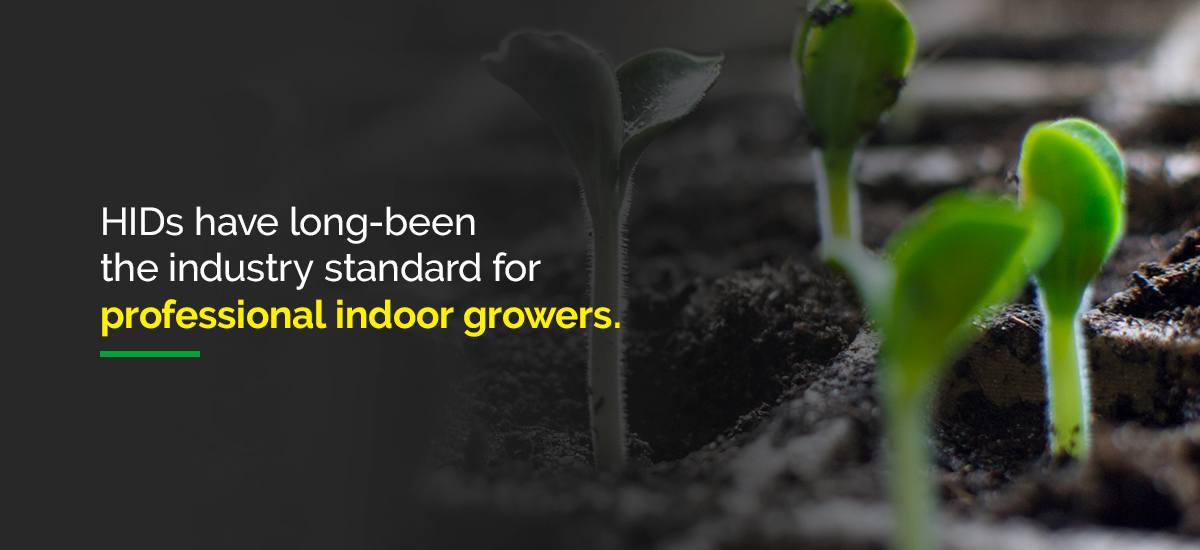
Pros of HID
HIDs have long-been the industry standard for professional indoor growers. As such, they offer many benefits to home growers, too.
They’re More Consistent and Have Better Light Penetration
What yields more — HPS or LEDs? While you’ll find anecdotal evidence either way, the consensus points to HPS and HIDs. LEDs are known for their incredible light intensity, but HIDs tend to have consistent quality light and better canopy penetration. More light can reach below your plants’ canopy, distributing light to the lower leaves and stems.
LEDs do not project well over long distances, and growers must adjust the lights as their plants grow to maintain the right overhead clearance for growth. The correct distance varies by model. In other words, the light intensity near the diodes is far greater than it is a foot or two away. The difference in intensity for an HID bulb is much less significant in general. With HIDs, plants get adequate light even when they’re farther away from the light source.
HIDs have proven themselves reliable. They can increase plant yield, growth and productivity in your grow room. Besides the consistent light quality, HIDs are also more well established. Growers have more information about best practices, helping them get the most out of their crops.
They’re More Affordable Upfront
HIDs are a long-established technology available for an affordable price. Growers can often buy an entire HID lighting system, including the baffles, reflectors and bulbs, for less than the cost of a high-end, all-in-one LED system.
The lower upfront cost, combined with a higher yield per light, often makes these lights the superior option. Even when considering the lifetime operating costs, HIDs may still be kinder to your wallet.
They All Provide Full-Spectrum Light
The goal of using artificial light is to replicate the natural sunlight plants would receive in nature. While adjusting the color temperature has its benefits, plants need all wavelengths to convert light into food. Consistent sunlight will always nourish your plants better than the same amount of artificial light.
HIDs offer full-spectrum light, and the individual types can introduce extra blue or red wavelengths. Even full spectrum LEDs can’t replicate natural light quite as well as HIDs. Ceramic metal halide lights are famous for their sunlight-like quality. Plants grown under full spectrum HIDs are guaranteed to receive all of the wavelengths required for growth because they have a complete light spectrum.
They’re More Standardized
The specifications from HID grow light manufacturers have more consistency than LEDs. When you buy an HID, you know what you’re getting, no matter the brand. HIDs are all used in similar ways and have established outputs and recommended distances to help you plan your grow room setup.
Cons of HID
While HIDs are popular for their high yields and healthier plants, they have some drawbacks, too. They might not be the right choice for every grow room.
They Are Less Energy-Efficient
While HID lights are cheaper initially, eventually, the added electricity cost could outweigh the cost advantage. Turning energy into light inside an HID tube is inherently less efficient. You lose energy through the chemical reaction and the ballast converter. Since they run hotter, they also raise your energy costs through more cooling and ventilation. HIDs lose efficiency over their life span as well.
While these drawbacks are significant, modern HID bulbs have become more efficient. They cost more in electricity, but it will likely take a few years before the added costs catch up to the lower initial investment.
They Require More Maintenance
Working with HIDs makes some parts of your grow room more complicated. First, the lights will burn out sooner, and you’ll have to replace bulbs more often than LED fixtures. Since HIDs don’t have a customizable light spectrum, you must also physically change out bulbs to get blue or red light. Finally, with more components in an HID setup, you increase the risk of something breaking. The ballasts, light bulbs, external timers and fans can all break down and require replacements.
The one area that doesn’t require more maintenance is adjusting the light height. As your plants grow, they’ll still receive consistent light from an HID. You’ll spend less time moving your lights up and down above your canopy. This is an area where it’s up to you to decide what type of maintenance you’d rather perform.
They Dim and Burn Out More Quickly
HIDs have a shorter life span than LEDs. Besides the added maintenance involved in switching out bulbs, you’ll also spend more money on replacements. Even before an HID bulb burns out, it will become dimmer. To maintain adequate light intensity for your plants, you’ll likely have to replace the lights sooner. In a small setup with just a few bulbs, you might not mind screwing in bulbs and occasionally eating the cost of a new one. However, in a more extensive setup, changing bulbs becomes a heavier workload.
They Produce More Heat
HIDs naturally produce heat since the gas inside the tube must be super-heated to create light. While HIDs are more efficient as they warm up, growers cannot take full advantage of the extra heat to improve energy efficiency. When you use HIDs, you must also use cooling fixtures to prevent your grow room from overheating. Not all growers will feel the effects of the extra heat the same way. Some setups need separate ventilation, and others can get away with a home air conditioning unit.
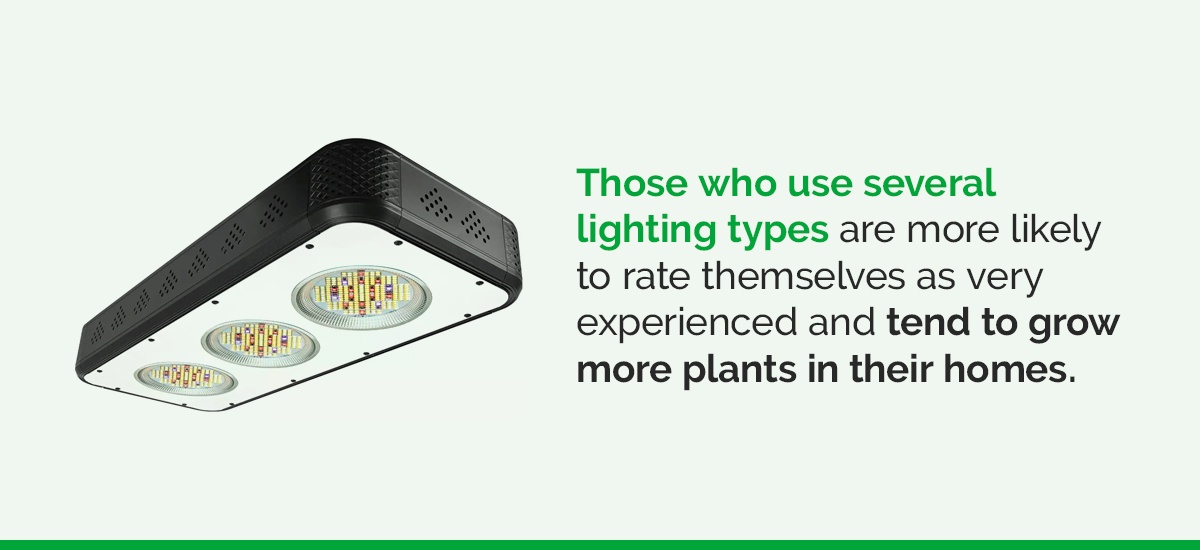
A Comparison of HID and LED Grow Lights and When to Use Each Type
Are LED grow lights better than HIDs? The truth is, it depends. With benefits and disadvantages to each, one grower’s best option may be different from the next. Many growers even combine LEDs and HIDs. Those who use several lighting types are more likely to rate themselves as very experienced and tend to grow more plants in their homes.
Using both in your grow house is a great way to get all the benefits your plants deserve and counteract some of the drawbacks. Some growers use different lights for each stage of growth. LEDs work best during the seedling and vegetative stages. The cooler lights are less likely to damage juveniles, and the 18 hours of light needed during vegetation are cheaper with an energy-efficient LED. HIDs become a better option during the flowering stage. The red wavelengths in HIDs better replicate fall sunlight, which is when cannabis plants naturally bloom.
Each lighting type can work well for specific scenarios. Rather than choosing a winner and a loser, it makes more sense to discuss when to use LED vs. HID grow lights.
When to Choose HID Grow Lights
You’ll probably prefer HIDs if:
- You want better light penetration: HIDs are known for their reliability and light penetration. You’ll spend less time adjusting your lights.
- Upfront costs are prohibitive: A quality HID is more affordable upfront. If you can’t spend a lot on your grow room right off the bat, an HID setup will help you get started without breaking the bank.
- You don’t mind changing the bulbs: For a home grower with just a few plants, changing a bulb every so often doesn’t take much effort. If changing the bulbs doesn’t bother you, HIDs aren’t a lot of maintenance.

- You want a full spectrum: A more complete light spectrum means healthier plants. If this is important to you, opt for CMH lights.
- Maximum yield is a must for you: With HIDs, it’s possible to create larger plants. If you have limited space, HIDs can help you gain larger yields and maximize space efficiency.
When to Choose LED Grow Lights
You might prefer LED grow lights if:
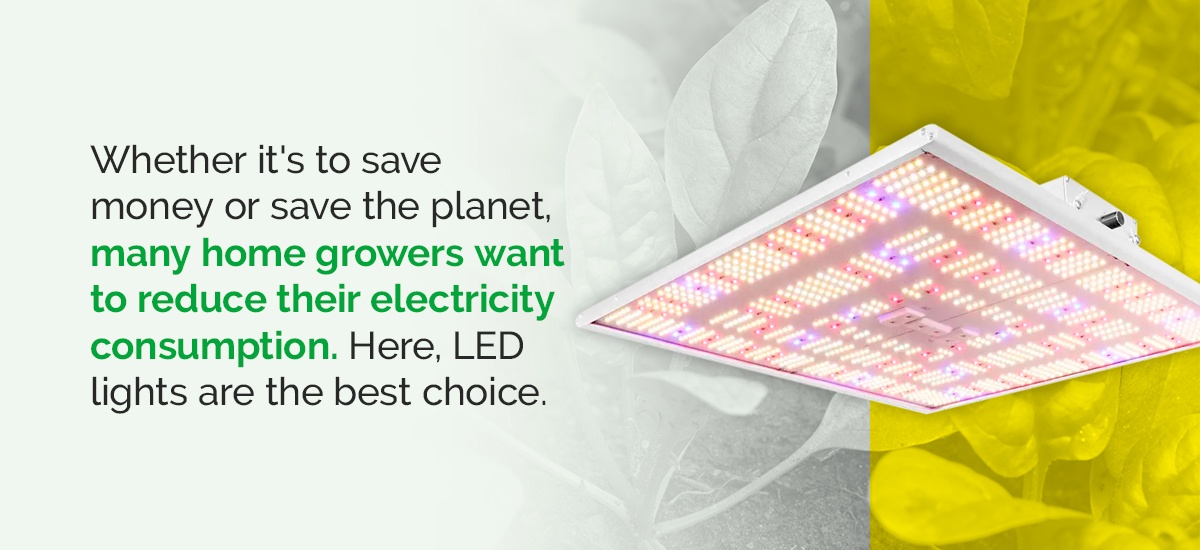
- Energy efficiency is important to you: Whether it’s to save money or save the planet, many home growers want to reduce their electricity consumption. Here, LED lights are the best choice.
- You can afford to invest more: If you’re playing the long game and have more money to spend, go with LEDs. You’ll spend more now to save more down the road.
- Adjusting the light isn’t a big deal: LEDs usually need to stay 6-18 inches above the canopy to maximize light penetration while avoiding light burn. If your schedule lets you check in on your plants often and move the lights as needed, you might not mind the frequent adjustments.

- You want to experiment with light spectrums: Growers often enjoy customizing their light temperature and settings to find the right combination for their plants in each growth stage. If you work with lots of different plant species or strains or want to have the ability to easily tweak your light formula, LEDs are for you.
- You want to plug and play: LED grow lights are an all-in-one system. Those who just want a simple way to grow plants at home will love that they can buy one fixture, plug it in and get planting.
Find the Right Option With HTG Supply
At HTG Supply, our home growing product selection is unmatched. Lighting fixtures are our specialty, and we have every type of grow light you could possibly want for your grow room. We can help you decide between HPS and LED grow lights and offer LED, HPS, MH, CMH and T5 lighting systems. Mix and match your lamps to customize your grow room, or find your favorite type of light in your preferred specifications. With such a vast selection, you can find your ideal grow system at a price point that meets your budget.
Visit our online shop to browse grow light systems, replacement bulbs and lighting accessories.
